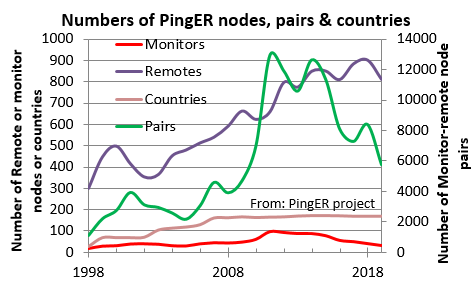
Q1: It seems that it is rather old technology. I wonder whether it is still effective for monitoring current situations or not.
Les>
It is old technology. In particular:
The advantage is it is standard over almost 20 years worth of data. It also focuses on places with poor connectivity (the Digital Divide). Further this data is freely available via anonymous FTP.
Newer technologies such as Akamai (see https://www.akamai.com/us/en/our-thinking/state-of-the-internet-report/state-of-the-internet-connectivity-visualization.jsp which goes back quarter by quarter to 2007 with Akamai download speeds by country with a linear y scale. The full report is at: https://content.akamai.com/pg8228-q4-2016-soti-connectivity-report.html) and perfSONAR only have data going back a few years. An alternative approach is to mine this data (it is available via csv files) develop the aggregations
The traceroute.pl tool (for remote traceroutes and pings) supports IPv6, is part of perfSONAR and is independent of PingER. Even if you don’t install a PingER MA (pinger2.pl) I would recommend installing these.
Q2: I'm afraid whether such monitoring will do harm to the security and safety of our own hosts and related facilities or not.
Les>There has been no evidence of this. Considerable thought was given to this in the implementation.
Q3: I feel that we can do some useful things using the data monitored. Is it free to use such data if we participate in the monitoring? Furthermore, can we use all the data or only limited usage of the data.
Les> The data is public and free to use. You can use whatever you want. The data is updated daily.
Q4: Future support
Les> The most time-consuming part is working with the various contacts to keep all the Measurement Agents running. Some sites are concerned about old equipment, or possible security issues, or the contacts have left etc. Thus next year I may just keep SLAC running and not worry about others dis-appearing.
Les> 2019: PingER is now over 21 years old and a lot has happened in that time. For example, when the Budker Institute at Novosibirsk joined in 2000 their link was 128kbps through KEK to the Internet. This was typical and further there was a lot of unreliability since there was little redundancy, and the users tended to be experts. Now everybody uses the Internet and just expect it to work all the time and we no longer just use it for file transfer, email, and the web but use it for streaming movies, phone calls, shopping etc. etc. The net result is that the Internet is now very reliable, and easy to use and the initial purpose of PingER for monitoring HEP sites, for example, to determine where to locate repositories etc. is no longer its purpose. In addition, many of the contacts at the almost 100 MA sites (at one time 6 or 7 years ago) are getting to or have retired or moved on and there are no new contacts who will assist. Further, we no longer have a steady influx of students from Pakistan or Brazil who add new features, extend existing ones or make significant advances in the analyses.
The attached Excel image shows the growth and decline of PingER. The number of remote sites and countries pinged is fairly steady since it is mainly driven by the SLAC MA which I keep running. However, the number of MAs (monitors) and pairs (monitor-remote site) have declined dramatically since the heyday.
